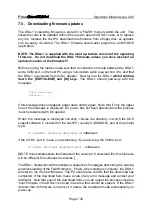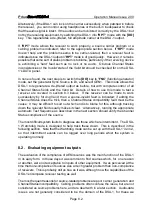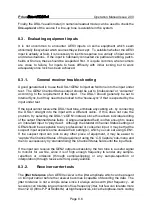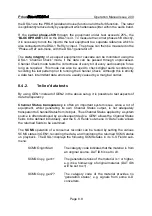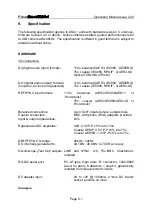
Prism
Operation Manual Issue 2.00
Page 8.2
Alternatively, if the DSA-1 can lock on the carrier successfully when patched in before
the receiver, you can monitor using headphones or the built-in loudspeaker to check
that the audio signal is intact. If the audio can be monitored correctly by the DSA-1 but
not by the receiving equipment, try switching the DSA-1 into 'RPT' mode with the [DO]
key. This regenerates a de-jittered, full amplitude carrier at the DSA-1 output.
If 'RPT' mode allows the receiver to work properly, a source carrier problem or a
cabling problem is indicated; refer to the appropriate section below. If 'RPT' mode
doesn't help and the problem seems to be carrier-related, then a receiver fault is
indicated since the DSA-1 output in 'RPT' mode is of good quality. However, it remains
possible that some sort of status problem is to blame, particularly if the receiving device
is exhibiting a 'hard' fault such as no lock or no audio. Obvious Channel Status
inconsistencies or the 'invalid' state of the Valid bit should be checked for on the DSA-
1's DATA panel.
In none is found, the next step is to switch the [DO] key to 'FNC' (function generator)
mode, set the generator Sync Source to DI, and select GEN1. This mode allows the
DSA-1 to regenerate a de-jittered output as before, but with complete control of all
Channel Status fields and the Valid bit. Details of how to use this mode to test a
receiver are covered in section 8.3 below. If the receiver can be made to work
successfully by forcing Valid, then a source-invalid fault is indicated; if editing the
Channel Status does the trick, then a Channel Status compatibility fault must be the
cause. It may be difficult to sort out which end is to blame for this, although tracking
down the relevant field usually makes it clear. Alternatively, running the appropriate
automatic Test Sequence as described in the next section should verify the Channel
Status compliance of the source.
The most difficult system faults to diagnose are those which are intermittent. The DSA-
1 Watchdog mode is designed to help track these down. This is described in the
following section. Note that the Watchdog mode can be set up with the DSA-1 'in-line',
so that intermittent events can be logged over long periods whist the system is
operating normally.
8.2. Evaluating equipment outputs
The evaluation of the compliance of AES3 sources was the main function of the DSA-1
in its early form. In those days it was common to find sources which, for one reason
or another, were not acceptable to inputs of other equipment. It was perceived at the
time that non-compliance of sources was a much greater problem than non-compliance
of receivers. This is probably still as true as it was, although now the capabilities of the
DSA-1 encompass receiver testing as well.
The most frequent reasons for source-related problems are poor carrier generation and
Channel Status incompatibility. Cabling problems often confuse the issue, but are not
considered as source problems here, and are dealt with in a later section. Audio-data
issues are not generally considered to be the domain of the DSA-1, for these we












